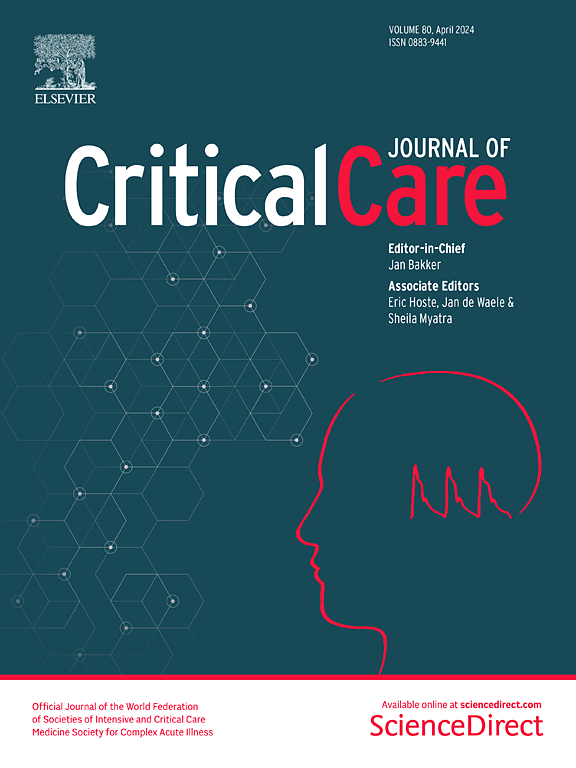Cardiopulmonary bypass and VA-ECMO induced immune dysfunction: common features and differences, a narrative review
IF 8.8
1区 医学
Q1 CRITICAL CARE MEDICINE
引用次数: 0
Abstract
Cardiopulmonary bypass (CPB) and veno-arterial extracorporeal membrane oxygenation are critical tools in contemporary cardiac surgery and intensive care, respectively. While these techniques share similar components, their application contexts differ, leading to distinct immune dysfunctions which could explain the higher incidence of nosocomial infections among ECMO patients compared to those undergoing CPB. This review explores the immune modifications induced by these techniques, comparing their similarities and differences, and discussing potential treatments to restore immune function and prevent infections. The immune response to CPB and ECMO involves both humoral and cellular components. The kinin system, complement system, and coagulation cascade are rapidly activated upon blood contact with the circuit surfaces, leading to the release of pro-inflammatory mediators. Ischemia–reperfusion injury and the release of damage-associated molecular patterns further exacerbate the inflammatory response. Cellular responses involve platelets, neutrophils, monocytes, dendritic cells, B and T lymphocytes, and myeloid-derived suppressor cells, all of which undergo phenotypic and functional alterations, contributing to immunoparesis. Strategies to mitigate immune dysfunctions include reducing the inflammatory response during CPB/ECMO and enhancing immune functions. Approaches such as off-pump surgery, corticosteroids, complement inhibitors, leukocyte-depleting filters, and mechanical ventilation during CPB have shown varying degrees of success in clinical trials. Immunonutrition, particularly arginine supplementation, has also been explored with mixed results. These strategies aim to balance the inflammatory response and support immune function, potentially reducing infection rates and improving outcomes. In conclusion, both CPB and ECMO trigger significant immune alterations that increase susceptibility to nosocomial infections. Addressing these immune dysfunctions through targeted interventions is essential to improving patient outcomes in cardiac surgery and critical care settings. Future research should focus on refining these strategies and developing new approaches to better manage the immune response in patients undergoing CPB and ECMO. Although often considered similar, CPB and ECMO have distinct immune repercussions. Numerous immunomodulatory strategies have been tested in cardiac surgery patients undergoing CPB to mitigate the induced immunoparesis, but no clinical trials have been conducted for patients on ECMO. C5aR (complement component 5a receptor), CPB (cardiopulmonary bypass), DC (dendritic cells), ECMO (extracorporeal membrane oxygenation), HLA-DR (human leukocyte antigen-DR isotype), NETs (neutrophil extracellular traps), PD-1 (program cell death protein 1), ROS (reactive oxygen species), TLR (toll-like receptor). Created with BioRender.com心肺旁路和 VA-ECMO 诱导的免疫功能障碍:共同点和差异,叙述性综述
心肺旁路术(CPB)和静脉-动脉体外膜肺氧合分别是当代心脏手术和重症监护的重要工具。虽然这些技术具有相似的组成部分,但其应用环境不同,导致了不同的免疫功能障碍,这也是 ECMO 患者的院内感染发生率高于 CPB 患者的原因。本综述探讨了这些技术引起的免疫改变,比较了它们的异同,并讨论了恢复免疫功能和预防感染的潜在治疗方法。对 CPB 和 ECMO 的免疫反应涉及体液和细胞两部分。血液接触回路表面后,激肽系统、补体系统和凝血级联迅速激活,导致促炎介质的释放。缺血再灌注损伤和损伤相关分子模式的释放进一步加剧了炎症反应。细胞反应涉及血小板、中性粒细胞、单核细胞、树突状细胞、B 淋巴细胞和 T 淋巴细胞以及髓源性抑制细胞,所有这些细胞都会发生表型和功能改变,从而导致免疫抑制。缓解免疫功能障碍的策略包括减少 CPB/ECMO 期间的炎症反应和增强免疫功能。在临床试验中,非泵手术、皮质类固醇、补体抑制剂、白细胞清除过滤器和 CPB 期间的机械通气等方法都取得了不同程度的成功。免疫营养,尤其是精氨酸的补充,也在探索之中,但结果不一。这些策略旨在平衡炎症反应并支持免疫功能,从而降低感染率并改善预后。总之,CPB 和 ECMO 都会引发显著的免疫改变,增加对医院内感染的易感性。通过有针对性的干预措施来解决这些免疫功能障碍,对于改善心脏手术和重症监护环境中患者的预后至关重要。未来的研究应侧重于完善这些策略和开发新的方法,以更好地管理接受 CPB 和 ECMO 患者的免疫反应。尽管 CPB 和 ECMO 通常被认为是相似的,但它们却有不同的免疫反应。许多免疫调节策略已在接受 CPB 的心脏手术患者中进行过测试,以减轻诱发的免疫抑制,但尚未对接受 ECMO 的患者进行过临床试验。C5aR(补体成分 5a 受体)、CPB(心肺旁路)、DC(树突状细胞)、ECMO(体外膜氧合)、HLA-DR(人类白细胞抗原-DR 同种型)、NETs(中性粒细胞胞外捕获器)、PD-1(程序性细胞死亡蛋白 1)、ROS(活性氧)、TLR(收费样受体)。使用 BioRender.com 创建
本文章由计算机程序翻译,如有差异,请以英文原文为准。
求助全文
约1分钟内获得全文
求助全文
来源期刊

Critical Care
医学-危重病医学
CiteScore
20.60
自引率
3.30%
发文量
348
审稿时长
1.5 months
期刊介绍:
Critical Care is an esteemed international medical journal that undergoes a rigorous peer-review process to maintain its high quality standards. Its primary objective is to enhance the healthcare services offered to critically ill patients. To achieve this, the journal focuses on gathering, exchanging, disseminating, and endorsing evidence-based information that is highly relevant to intensivists. By doing so, Critical Care seeks to provide a thorough and inclusive examination of the intensive care field.
 求助内容:
求助内容: 应助结果提醒方式:
应助结果提醒方式:


